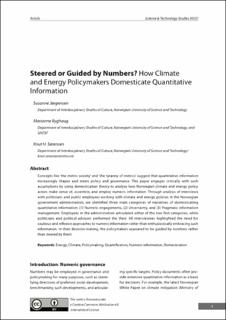| dc.contributor.author | Jørgensen, Susanne | |
| dc.contributor.author | Ryghaug, Marianne | |
| dc.contributor.author | Sørensen, Knut Holtan | |
| dc.date.accessioned | 2024-04-16T08:42:55Z | |
| dc.date.available | 2024-04-16T08:42:55Z | |
| dc.date.created | 2024-04-15T12:38:25Z | |
| dc.date.issued | 2024 | |
| dc.identifier.issn | 2243-4690 | |
| dc.identifier.uri | https://hdl.handle.net/11250/3126713 | |
| dc.description.abstract | Concepts like 'the metric society' and 'the tyranny of metrics' suggest that quantitative information increasingly shapes and steers policy and governance. This paper engages critically with such assumptions by using domestication theory to analyse how Norwegian climate and energy policy actors make sense of, assemble, and employ numeric information. Through analysis of interviews with politicians and public employees working with climate and energy policies in the Norwegian government administration, we identified three main categories of narratives of domesticating quantitative information: (1) Numeric engagements, (2) Uncertainty, and (3) Pragmatic information management. Employees in the administration articulated either of the two first categories, while politicians and political advisors performed the third. All interviewees highlighted the need for more cautious and reflexive approaches to numeric information rather than enthusiastically embracing such information. In their decision-making, the policymakers appeared to be guided by numbers rather than steered by them. | en_US |
| dc.language.iso | eng | en_US |
| dc.publisher | Finnish Society for Science and Technology Studies | en_US |
| dc.rights | Navngivelse 4.0 Internasjonal | * |
| dc.rights.uri | http://creativecommons.org/licenses/by/4.0/deed.no | * |
| dc.title | Steered or Guided by Numbers? How Climate and Energy Policymakers Domesticate Quantitative Information | en_US |
| dc.title.alternative | Steered or Guided by Numbers? How Climate and Energy Policymakers Domesticate Quantitative Information | en_US |
| dc.type | Peer reviewed | en_US |
| dc.type | Journal article | en_US |
| dc.description.version | publishedVersion | en_US |
| dc.source.journal | Science & Technology Studies | en_US |
| dc.identifier.doi | https://doi.org/10.23987/sts.85773 | |
| dc.identifier.cristin | 2261658 | |
| dc.relation.project | Norges forskningsråd: 296205 | en_US |
| cristin.ispublished | true | |
| cristin.fulltext | original | |
| cristin.qualitycode | 1 | |

